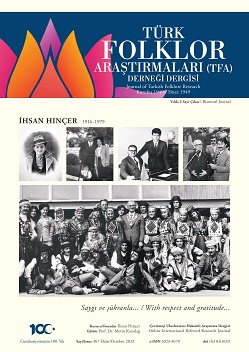İSTANBUL KENT FOLKLORU BAĞLAMINDA ŞEHRİN DEĞİŞEN DANS MANZARASI
Anahtar Kelimeler:
İstanbul folkloru, kent folkloru, halk dansları.Özet
Çoğunlukla tarihsel bir bakış açısıyla ele alınan ‘İstanbul folkloru’ üzerine olan çalışmaların büyük bir kısmı genelde şehrin kuruluş efsaneleri ve belli mekânları üzerine inanışlar üzerinde durmuştur. Ne var ki bugünün kent folkloru hem maddi kültürel değişimleri hem de bu değişimlerin etnografik bağlamda yapılanan sosyal gruplarının ürettikleri türlü sanatsal iletişim formlarını da kapsar. Bu makale İstanbul’da icra edilen dans türlerinin 1980'lerden bu yana yaşadığı değişimi ve farklı dans deneyimlerinin kent folkloru bağlamında bir değerlendirmesini kapsamaktadır. Geleneksel "dans" kavramı Cumhuriyetin ilk yıllarından beri Türk halk oyunlarıyla sınırlıyken, 1990'lı yıllardan itibaren Roman dansı, oryantal dans ve farklı etnik dans formları (İrlandalı, Perulu veya Afrikalı) İstanbul'un kamusal alanına görünürlük kazanmaya başladı. Özellikle farklı etnik grupların sokak performansları İstanbul’da hızla kabul gördü. Bu süreçte tango veya salsa gibi küresel olarak yayılan diğer Latin dans formları da 1990'lardan itibaren özel dans salonlarında kurumsallaşmaya başladılar. Cumhuriyetin ilk yıllarından itibaren dans, modernleşmenin kültürel bir sembolü de olmuştur. Batılılık ve Osmanlılık bağlamlarında dansın “dans” ve “oyun” olarak anılması da buna işaret eder.




